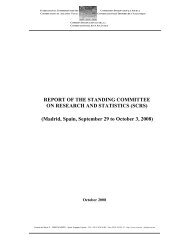E - Iccat
E - Iccat
E - Iccat
Create successful ePaper yourself
Turn your PDF publications into a flip-book with our unique Google optimized e-Paper software.
ICCAT REPORT 2012-2013 (I)<br />
The majority of spawning activity has been reported only in the Gulf of Mexico and the Mediterranean Sea.<br />
However, larvae collected east of the Yucatan Peninsula, and off the east coast of the U.S. originated from<br />
outside the Gulf of Mexico, possibly from the Caribbean Sea. Also, bluefin tuna tagged in New England and<br />
Canada did not enter the Gulf of Mexico, suggesting spawning elsewhere, near the Gulf Stream margin, possibly<br />
the Bahamas, and Caribbean Sea. Confirmation of the reproductive activity of bluefin tuna in the Atlantic is<br />
important for obtaining an accurate assessment of spawning stock biomass for western Atlantic bluefin tuna.<br />
Therefore, the Committee recommends that the CPCs support the continuation of these studies in order to<br />
properly identify and characterize spawning grounds of western Atlantic bluefin tuna, and improve the<br />
standardized abundance indices for the next western Atlantic bluefin tuna stock assessment or intersessional<br />
meeting.<br />
− To evaluate the bluefin tuna national observer programmes conducted by CPCs and to provide advice on<br />
future improvements [Rec. 10-04, paragraph 90] (see Item 18.2 of the 2012 SCRS Report).<br />
No new specific information has been provided. However, the data collection form for national observer<br />
programmes included some information regarding bluefin tuna observer programmes and a few flag States<br />
provided comments. The Committee recommended that the CPCs respond to [Rec. 10-04] and provide<br />
information on their national observer programmes.<br />
− To explore operationally viable technologies and methodologies for determining the size and biomass at the<br />
points of capture and caging [Rec. 10-04, paragraph 87] (see Item 18.10 of the 2012 SCRS Report).<br />
This Recommendation requests the CPCs to initiate pilot studies on how to better estimate both the number and<br />
weight of bluefin tuna at the point of capture and caging, including through the use of stereoscopic systems and<br />
report the results to the SCRS. The following SCRS documents regarding the use of stereoscopic camera<br />
systems were presented to the 2012 SCRS meeting:<br />
240<br />
◦ SCRS/2012/052: Stereoscopic camera to measure the length of fish in the cage and during the transfer to<br />
another cage through a gate. The authors affirmed the validity of utilization of the stereoscopic camera for<br />
counting and measuring bluefin tuna and made several suggestions for improving the procedure and<br />
equipment.<br />
◦ SCRS/2012/136: Stereoscopic camera was applied at the point of first transfer into the farm cage. The<br />
authors suggested that further work is required to improve the accuracy of measurement and better define<br />
the mathematical models needed.<br />
◦ SCRS/2012/133: A video-camera and acoustical system were used in tandem during the transfer of<br />
bluefin tuna from one cage to another. The authors described the various different equipment options<br />
available for the application of this technique and practical considerations for improving the accuracy of<br />
the system.<br />
The SCRS was encouraged by the progress made in the practical application of stereoscopic cameras and<br />
alternative techniques. The SCRS noted that a number of factors may affect the accuracy of the stereoscopic<br />
camera measurements. Nevertheless, the Committee stressed that measurements made by stereoscopic cameras<br />
are potentially more precise than the current catch at size reported for the purse seine fleet. The Committee<br />
recommended moving beyond the pilot study phase and setting up a technical working group to establish<br />
procedures for implementing stereoscopic camera systems by 2013.<br />
− To provide guidance on a range of fish size management measures for western Atlantic bluefin tuna and their<br />
impact on yield-per-recruit and spawner-per-recruit considerations [Rec. 10-03, paragraph 19] (see Item<br />
18.11 of the 2012 SCRS Report).<br />
The Committee recognized that Y/R and SSB/R could be improved by changing the selectivity pattern<br />
(decreasing the selectivity of ages 1-6 by 40% resulted in only modest improvements), but these would imply<br />
allocation changes with implications beyond strict Y/R and SSB/R considerations. The Committee was<br />
concerned that such changes in selectivity would affect the availability and utility of indices of stock sizes<br />
currently used in the assessment.<br />
6. Measures for the conservation of stocks and implementation of the ICCAT Criteria for the Allocation of<br />
Fishing Possibilities [Ref. 01-25]<br />
6.1 East Atlantic and Mediterranean bluefin tuna<br />
Recommendation 10-04 required the Commission to review and, if considered to be acceptable, endorse the<br />
fishing plans for eastern Atlantic and Mediterranean bluefin tuna submitted by CPCs. These plans are presented

















